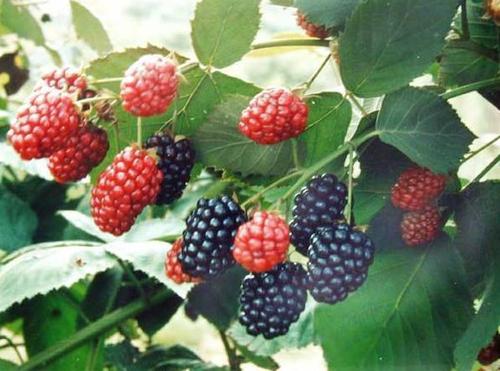 Morus
alba, Morus nigra Mulberry tree
Family: Moraceae
Morus
alba, Morus nigra Mulberry tree
Family: Moraceae
M. alba = white mulberry. M. nigra = black or purple mulberry.
 Morus
alba, Morus nigra Mulberry tree
Family: Moraceae
Morus
alba, Morus nigra Mulberry tree
Family: Moraceae
M. alba = white
mulberry. M. nigra = black or purple mulberry.

 ORIGIN:
Cultivated worldwide in temperate regions.
ORIGIN:
Cultivated worldwide in temperate regions. Mulberry (Morus alba L.) leaves and their major flavonol quercetin
3-(6-malonylglucoside) attenuate atherosclerotic lesion development in LDL receptor-deficient
mice.
Enkhmaa B, Shiwaku K, Katsube T, Kitajima K, Anuurad E, Yamasaki M, Yamane Y.
Abstract
The effects of dietary consumption of mulberry (Morus alba L.) leaves and their
major flavonol glycoside, quercetin 3-(6-malonylglucoside) (Q3MG), on the development
of atherosclerotic lesions, in relation to the susceptibility of plasma LDL
to oxidative modification, was studied in LDL receptor-deficient (LDLR-/-) mice.
Male mice aged 8 wk were randomly assigned to 4 groups (control, quercetin,
Q3MG, and mulberry). The control group was fed an atherogenic-diet containing
3 g cholesterol and 15 g cocoa butter/100 g. The other experimental groups were
fed the same atherogenic diet supplemented with 0.05 g quercetin/100 g for the
quercetin group, 0.05 g Q3MG/100 g for the Q3MG group, and 3 g dried mulberry-leaf
powder/100 g for the mulberry group. The mice were fed their respective diets
for 8 wk. The susceptibility of LDL to oxidative modification was significantly
decreased in the Q3MG- and mulberry-treated mice, as evidenced by the 44.3 and
42.2% prolongation of the lag phase for conjugated diene formation compared
with that of the control mice. The atherosclerotic lesion area in both the Q3MG-
and mulberry-treated mice was significantly reduced by 52% compared with that
of the controls. However, in the quercetin group, no protective effects were
observed against LDL oxidation or atherosclerotic lesion formation. In conclusion,
mulberry leaves attenuated the atherosclerotic lesion development in LDLR-/-
mice through enhancement of LDL resistance to oxidative modification, and these
antioxidative and antiatherogenic protective effects were attributed mainly
to Q3MG, the quantitatively major flavonol glycoside in mulberry leaves.
PMID: 15795425 J Nutr. 2005 Apr;135(4):729-34. ncbi.nlm.nih.gov
Phytochemistry, pharmacology, and clinical trials of Morus alba.
Chan EW, Lye PY, Wong SK.
Abstract
The present review is aimed at providing a comprehensive summary on the botany,
utility, phytochemistry, pharmacology, and clinical trials of Morus alba (mulberry
or sang shu). The mulberry foliage has remained the primary food for silkworms
for centuries. Its leaves have also been used as animal feed for livestock and
its fruits have been made into a variety of food products. With flavonoids as
major constituents, mulberry leaves possess various biological activities, including
antioxidant, antimicrobial, skin-whitening, cytotoxic, anti-diabetic, glucosidase
inhibition, anti-hyperlipidemic, anti-atherosclerotic, anti-obesity, cardioprotective,
and cognitive enhancement activities. Rich in anthocyanins and alkaloids, mulberry
fruits have pharmacological properties, such as antioxidant, anti-diabetic,
anti-atherosclerotic, anti-obesity, and hepatoprotective activities. The root
bark of mulberry, containing flavonoids, alkaloids and stilbenoids, has antimicrobial,
skin-whitening, cytotoxic, anti-inflammatory, and anti-hyperlipidemic properties.
Other pharmacological properties of M. alba include anti-platelet, anxiolytic,
anti-asthmatic, anthelmintic, antidepressant, cardioprotective, and immunomodulatory
activities. Clinical trials on the efficiency of M. alba extracts in reducing
blood glucose and cholesterol levels and enhancing cognitive ability have been
conducted. The phytochemistry and pharmacology of the different parts of the
mulberry tree confer its traditional and current uses as fodder, food, cosmetics,
and medicine. Overall, M. alba is a multi-functional plant with promising medicinal
properties.
Chin J Nat Med. 2016 Jan;14(1):17-30. doi: 10.3724/SP.J.1009.2016.00017. ncbi.nlm.nih.gov
Morus alba extract modulates blood pressure homeostasis through eNOS
signaling.
Carrizzo A, Ambrosio M, Damato A, Madonna M, Storto M, Capocci L, Campiglia
P, Sommella E, Trimarco V, Rozza F, Izzo R, Puca AA, Vecchione C.
Abstract
SCOPE:
Morus alba is a promising phytomedicine cultivated in oriental countries that
is extensively used to prevent and treat various cardiovascular problems. To
date, despite its beneficial effects, the molecular mechanisms involved remain
unclear. Thus, we investigate the vascular and haemodynamic effects of Morus
alba extract in an experimental model focusing our attention on the molecular
mechanisms involved.
METHODS AND RESULTS:
Through vascular reactivity studies, we demonstrate that Morus alba extract
evokes endothelial vasorelaxation through a nitric oxide-dependent pathway.
Our molecular analysis highlights an increase in endothelial nitric oxide synthase
(eNOS) phosphorylation. In vivo administration of Morus alba extract reduces
blood pressure levels exclusively in wild-type mice, whereas it fails to evoke
any haemodynamic effects in eNOS-deficient mice. Molecular analyses revealed
that its beneficial action on vasculature is mediated by the activation of two
important proteins that act as stress sensors and chaperones: PERK and heat
shock protein 90. Finally, Morus alba extract exerts antihypertensive action
in an experimental model of arterial hypertension.
CONCLUSION:
Through its action on eNOS signaling, Morus alba extract could act as a food
supplement for the regulation of cardiovascular system, mainly in clinical conditions
characterized by eNOS dysfunction, such as arterial hypertension.
Mol Nutr Food Res. 2016 May 28. doi: 10.1002/mnfr.201600233. [Epub ahead of
print] ncbi.nlm.nih.gov